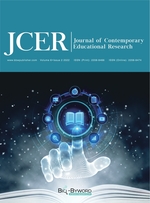Abstract
It is of great significance to optimize the spatial matching of basic education facilities in rural areas and promote the equalization of urban and rural basic public services and the overall revitalization of rural areas. Based on the theory of spatial accessibility and spatial balance of supply and demand, this paper constructs the evaluation system of rural basic education facilities and layout rationality. In this study, we took 42 primary and secondary schools and 2089 rural areas with concentrated population in six township areas of Hancheng City as the research subjects. We used ArcGIS network analysis, population coupling model, and other methods, from the administrative scale and rural population concentration area scale for evaluation. The accessibility of basic education facilities and its coupling relationship with the spatial distribution of student population describe the spatial and geographical pattern of basic education facilities in rural areas. The results show that the accessibility of rural administrative scale and the spatial balance of supply and demand of population concentration area scale are associated with great problems, the differences between towns are obvious, and the overall level of the best performing towns is still low. On the scale of population concentration area, the overall coupling degree is too low, the “dislocation” distribution of educational facilities and student population is obvious, and the matching degree of the student population and school in different towns is significantly different, showing a more obvious “core-periphery” spatial structure characteristics centered on the eastern and southeast regions. The terrain characteristics of rural areas in Shaanxi province are prominent, and the accessibility of the road network is particularly significant. Therefore, optimizing the construction of rural roads and optimizing school layout according to local conditions will become an important solution to promote the balanced allocation of basic education resources in Shaanxi province.
References
Hansen WG, 1959, How Accessibility Shapes Land Use. J. Am. Plan. Assoc. https://doi.org/10.1080/01944365908978307
Kelobonye K, Mao F, Xia J, et al., 2019, The Impact of Employment Self-Sufficiency Measures on Commuting Time: A Case Study of Perth, Australia. Sustainability, 11(5): 1488.
Kelobonye K, Zhou H, McCarney G, et al., 2020, Measuring the Accessibility and Spatial Equity of Urban Services Under Competition Using the Cumulative Opportunities Measure," J. Transp. Geogr., 85: 102706.
Song Z, 2010, Spatial Accessibility of Medical Services Based on Improved Potential Model and Determination of Areas with a Shortage of Medical Services: The Case of Rudong County, Jiangsu Province. Geoscience, 30(02): 213-219.
Tao Z-L, Cheng Y, Dai T, 2014, Spatial Accessibility Evaluation of Elderly Facilities in Beijing. Advances in Geographical Sciences, 33(05): 616-624.
Wang F, 2009, Quantitative Methods and Applications Based on GIS. The Commercial Press.
Joseph AE, Phillips DR, 1984, Accessibility and Utilization: Geographical Perspectives on Health Care Delivery. Access. Util. Geogr. Perspect. Heal. Care Deliv. https://doi.org/10.2307/633309
Zhang Y, 2016, Definition of Regional Spatial Equilibrium Connotation and State Assessment from the Perspective of Supply and Demand Drive - An Example from Shandong Province. Soft Science, 30(12): 54-58.
Fan J, 2007, The Scientific Basis of the Zoning of the Main Functions in China. Journal of Geography, 2007(04): 339-350.
Higgins B, Savoie DJ, Higgins B, et al., 2019, Interregional and International Trade, in Regional Development Theories & Their Application.
Allen T, Arkolakis C, 2014, Trade and the Topography of the Spatial Economy, Q. J. Econ. https://doi./org/10.1093/are/qju016
Boyce MS, 2006, Scale for Resource Selection Functions. Diversity and Distributions, 12(3): 269-276.
Holmes TJ, Fujita M, Krugman P, et al., 2000, The Spatial Economy: Cities, Regions, and International Trade. South. Econ. J., 67(2): 491-493. https://doi.org/10.2307/1061487
Ray ZK, Chen W, Sun W, 2008, A Study on Productivity Layout Based on the Concept of Spatial Equilibrium: The Case of Wuxi City. Geographical Research and Development, 2008(01): 19-22, 27.
Lu DD, 2009, 2050: China’s Regional Development. Science Press.
Chen W, Sun W, Zhao H, 2010, Spatial Imbalance Patterns and State Assessment of Regional Development: The Case of Jiangsu Province. Journal of Geography, 65(10): 1209-1217.
Fan J, Zhou K, Chen D. 2013, Innovation and Application Practice of Economic Geography Research in Optimizing the Spatial Development Pattern of National Land in the Construction of Ecological Civilization. Economic Geography, 33(01): 1-8.
Jing B, 2020, Study the Equilibrium State of the Human-Land Relationship and Spatial Control in the Qinba Mountains Based on the Supply-Demand Matching Model. Yangtze River Basin Resources and Environment, 29(03): 654-667.
Song X, 2014, Exploration and improvement of urban primary and secondary school layout planning methods. Urban Planning, 38(08): 48-56.
Yang X, Alain C, Song X, 2014, Limitations of Spatial Syntax in Urban Planning and Ways to Improve and Expand It. Journal of Urban Planning, 2014(05): 32-38.
Song Y, 2015, Guide to the Application of GIS for Urban Spatial Analysis. China Construction Industry Press.
Chen L, 2019, Study on the Spatial Matching of Urban Public Service Facilities and Residential Neighborhoods - A Case Study of Lanzhou City. Arid Zone Resources and Environment, 33(11): 120-127.
